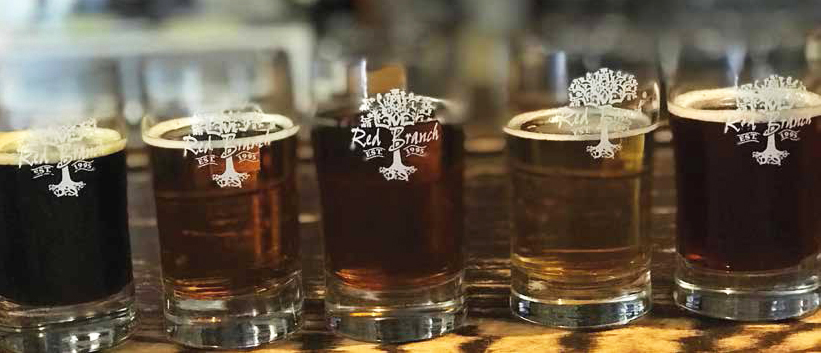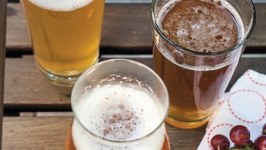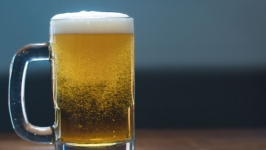Summer Fruit & Honey Beers
A new movement is taking hold in craft breweries up and down the Peninsula and South Bay, where you might smell heady peach, cherry, strawberry or orange blossom honey aromas. At its most basic, beer is water, grain, yeast and hops. Malting the grains results in what beer makers called fermentable sugars. But at these breweries, some fermentable grain sugars are being replaced by just about any type of fruit or honey you can imagine. Fruity or honeyed brews don’t get their floral, citrus, berry or tropical notes from hops or yeast strands, a common way to flavor beer. Instead, brewers add juice or purée, fresh fruit or honey. While you’ll still find plenty of monster IPAs, Silicon Valley brewery taps are bursting with fruit and honey.
Fruit-Forward Beer
San Jose’s Hermitage Brewing Company occupies a 50,000-squarefoot warehouse, divided in two. IPAs, pilsners, lagers, porters and stouts are made and aged in the fermentation cellar. Then there’s the sour annex, a cellar full of beers made with yeast strains that turn beer sour. At Hermitage, most sours are flavored with citrus, stone or berry fruit.
Head brewer and cellar master Greg Filippi says fruit and beer have always been a natural pairing, coming out of Europe’s Franco- Belgian region, where cherry, apricot, strawberry and peach sours were traditional. He launched Hermitage’s American Sour program in 2014 with a boysenberry beer.
Greg adds juice or purée to the base beer, which has already been brewed and aged in barrel for about a year. Over the next three to six months, those fruit sugars ferment out, leaving a dry, but fruitforward beer. He matches the base beer’s grain and style profile to fruit. “If I wanted to do a very light beer with a subtle fruit like peach, I wouldn’t put that in black beer because you wouldn’t taste the fruit,” he says.
Before Hermitage’s fruit beers see the light of day they’ll spend up to two years in American or French oak barrels sourced from local wineries. But the barrelhead labels reveal special contents: blueberry and tropical funk projects. This summer look for Custom Crush, a Pinot Grigio sour made from Hollister grapes crushed at Gilroy’s The Stomping Ground.
Bees to Beer
In a small warehouse in San Jose’s SoFA district, Clandestine Brewing Company brewer Rob Conticello monitors an amber-colored wort (the sweet starter liquid for beer) heating up in a 31-gallon boil kettle. It comes to a rapid boil at 212°F. During the 90-minute boil, he’ll add hops and five minutes before the boil ends, he’ll pour in one pound of coffee blossom honey, yielding one barrel of beer after fermentation.
“The honey is only 1 or 2% of the fermentable sugars, but it has a huge flavor impact,” Rob says. “It makes the beer drier because honey ferments out so well, but retains its distinct honey flavor, not sweetness.”
It’s the latest of the small-batch experimental beers that Clandestine’s fans have come to anticipate. Rob is making Kottbusser, a vintage German beer style lost to the world until now. Rob’s mission is reviving older beer styles, and Kottbusser, with honey and a bit of molasses, fits the bill.
Clandestine also dabbles in fruit beers, especially in its signature milk stouts. To taste them you’ll have to head to Clandestine’s new taproom, which opened in February.
 Across the valley in Sunnyvale, honey is Red Branch Brewing Company’s key beer ingredient. Mike Faul may be better known for his Rabbit Foot’s mead, or honey wine, but he makes about half a dozen honey beers, called braggots.
Across the valley in Sunnyvale, honey is Red Branch Brewing Company’s key beer ingredient. Mike Faul may be better known for his Rabbit Foot’s mead, or honey wine, but he makes about half a dozen honey beers, called braggots.
“Technically, braggot is a style of mead,” Mike says. “To bring people in to try the more traditional meads, I needed something they are familiar with and that’s where honey beer came in.”
Honey can change the flavor profile, color, aroma and, most noticeably, the mouthfeel of beer. Honey beer is smoother and more viscous and usually higher in alcohol too. The amount of honey added depends on the beer style. For example, honey makes up 25% of the fermentable sugar in the Biere de Miel kolsch and 40% in the Honey Stout. But the honey doesn’t take over; the beers are dry.
Golden State Brewery’s Seth Hendrickson built his business around a honey beer recipe he perfected as a home brewer. “I thought honey ale would be different enough that people would want to try it,” he says, “but not so quirky that people would run away from it.”
Seth uses about 225 pounds of Florida orange blossom honey per batch for Golden State’s Heritage Honey Ale. “Honey adds alcohol and a mouthfeel and viscosity you don’t get in regular beer,” he says. “And there’s a citrus aroma and flavor.”
Heritage Honey is always on tap at Golden State’s Santa Clara and new Gilroy taprooms.
Where to taste fruit and honey beers
Clandestine Brewing Company, San Jose ClandestineBrewing.com
Red Branch Brewing Company at Rabbit’s Foot Meadery, Sunnyvale RabbitsFootMeadery.com
Golden State Brewery, Santa Clara and Gilroy, GoldenState.Beer
Hermitage Brewing Company, San Jose HermitageBrewing.com Other taps
Blue Oak Brewing, San Carlos BlueOakBrewing.com
Santa Clara Valley Brewing, San Jose SCVBrewing.com
Uproar Brewing Company, San Jose, UproarBrewing.com




